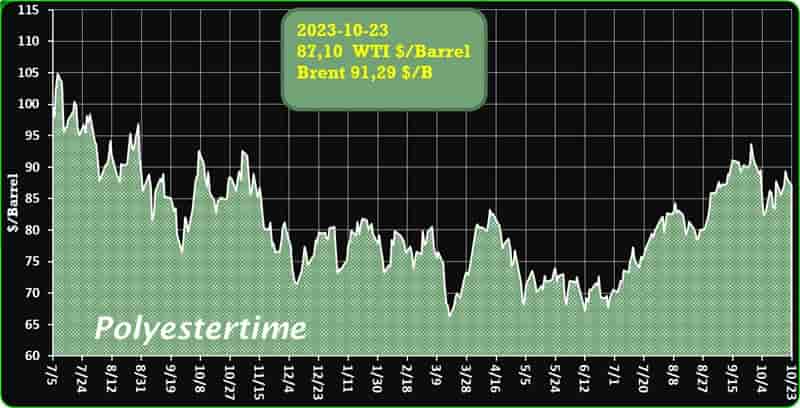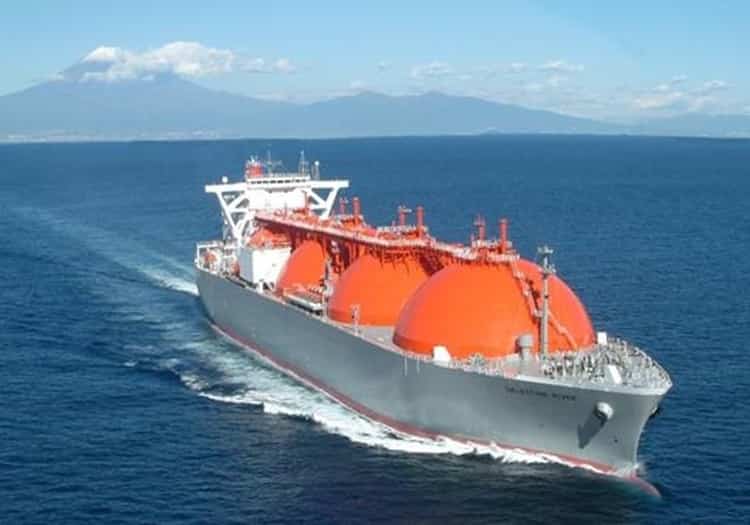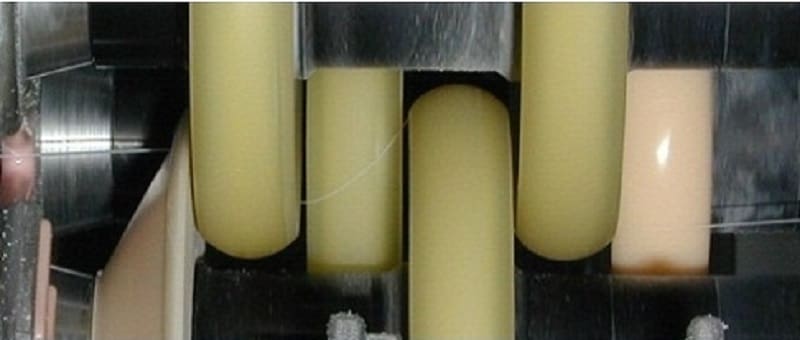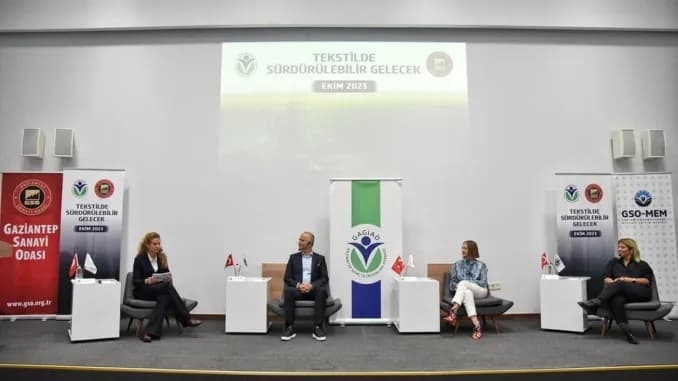Packaging films – Oil drops after Hamas releases US hostages : will it continue to go down? 23-10-2023
Packaging films
Petrochemicals chip – Panel for Sustainable Future in Textile in Gaziantep

Crude Oil Prices Trend

Crude Oil Prices Trend by Polyestertime
Oil drops after Hamas releases US hostages

“The Complex Nexus of Energy Transition: Lithium, Cobalt, Hydrogen”
The quest for achieving decarbonization and the energy transition presents a myriad of challenges. Are the essential raw materials readily available to support a fully electric mobility landscape? Will their extraction and utilization prove to be environmentally favorable? And is it economically viable for the industry? These are the inquiries that have long preoccupied global policymakers and major automotive conglomerates.
From the 22nd to the 25th of October, experts and professionals from diverse sectors convened in Palermo for the second iteration of the E2DT congress – Energy, Environment, and Digital Transition. This event was organized by the Italian Association of Chemical Engineering (AIDIC) with the endorsement of the European Federation of Chemical Engineering (EFCE). Packaging films
When we speak of energy and environmental transition, we typically refer to the shift from fossil fuel-based energy production to renewable resources. This path, as reiterated by analysts and companies, is neither straightforward nor devoid of costs. This transition necessarily unfolds within the realm of political choices, as exemplified by the European Commission’s recent stance on internal combustion engines. This stance has ignited a robust debate encompassing contrasting perspectives: those advocating for a swift farewell to fossil fuels, those advocating for a gradual shift, and those who argue that the current level of technological innovation permits a balanced compromise between environmental protection, industrial costs, and raw material availability.
“To this end, it is imperative that unbiased and scientifically sound information be accessible to decision-makers and regulators so that legislative changes are not influenced by partisan views,” underscores Giuseppe Ricci, President of AIDIC.
Additionally, digitalization assumes a pivotal role in this transition by expediting transformation processes.
Energy and production systems are increasingly becoming interconnected, intelligent, and efficient, equipped with self-learning capabilities, with profound implications for the labor landscape and, consequently, society. Packaging films
This challenge is global in scope. Recent developments in various parts of the world underscore this fact. Ghana, for instance, has inked an agreement with the Australian conglomerate Atlantic Lithium Ltd for the exploitation of a substantial lithium deposit, a key raw material in the spotlight. In a shift to South America, Chile is contemplating nationalizing its lithium reserves. Across Asia, China, which already holds a central position in the availability, exploitation, and processing of critical raw materials, has recently reached an accord to exploit lithium deposits in Afghanistan. In many regions of Europe, including France, Italy, and Scandinavia, searches are underway to identify potential sites for resource extraction. Simultaneously, the United Kingdom has postponed its ban on internal combustion engines from 2030 to 2035. Packaging films
A significant portion of Europe’s concerns stems from its status as primarily a consumer of materials essential to bolster the energy transition. It heavily relies on China and, to some extent, the United States for these resources. Furthermore, many of the fundamental elements required for electric batteries are sourced from politically unstable regions. Thus, the geopolitical aspect is far from inconsequential in the context of the energy transition.
AIDIC has crafted numerous position papers on critical metals, summarizing the primary challenges at hand. Batteries, for instance, impact not only electric mobility but also an array of everyday devices and objects, while simultaneously influencing the efficiency of renewable energy sources with their storage systems. Packaging films
Ricci cites a well-known study by the International Energy Agency (IEA) that zeroes in on batteries. This study reveals that, on average, an electric vehicle battery weighs approximately 206 kg and comprises a variety of metals, with graphite, copper, nickel, manganese, cobalt, lithium, and chromium being the most significant. When comparing the weight of individual materials used in batteries to the number of vehicles in circulation across Europe and worldwide, and then contrasting this with the availability of raw materials, it becomes evident that the critical issue revolves around cobalt and nickel. In an extreme scenario, there might not be enough cobalt to support a fully global fleet of electric vehicles. Packaging films

Hellweg defies odds, sees major sales increase
This year has been tough for a lot of plastic recyclers. Recycled resin prices have been under severe downward pressure for months because of persistent weak demand, competition from the falling cost of virgin plastics and cheaper imports from Asia.
On the show floor at Fakuma, there are some reports of double-digit percentage drops in sales for recycling machinery. But there are also surprisingly positive reports, with some companies saying they have not seen a drop in sales or have, even, experienced increased sales. Packaging films
Chief among them is perhaps Hellweg Maschinenbau, whose managing director, Mark Hellweg, gleefully said the company will have increased its output by 30 to 50 percent by the end of 2023 after already boosting sales by 50 percent in 2022.
“The first day at Fakuma was really good,” Hellweg said. “We had conversations throughout the entire day. For me, it was a very good day, like a very good Fakuma. So, I don’t see any negative impact right now. I don’t see it, and I don’t feel it. People were a little bit nervous during the last month. I have also seen that in our customers. But yesterday I had no chance to feel it here. Optimism what all I was met with yesterday.”
At the core of Hellweg’s success is the new MDSGi 1500/600 wet grinder, which it is unveiling and starting to sell at Fakuma. The machine has been under development for the past three years after Repetco contacted Hellweg and was “absolutely impressed” with the results of the grinding tests, Hellweg said. Packaging films
The Spain-based new entrant to the recycling of PET/polyethylene multilayer packaging ordered four prototypes that have been in operation 24/7 since the beginning of the year. Even though Hellweg only just started commercialization at Fakuma, it already received six orders for the rest of the year, and another eight are booked for 2024.
The new wet grinder uses low-power motors rated from 45 kW to 110 kW, which enable previously unattained low power consumption of just 70 kWh to 90 kWh, a huge advantage during the current high electricity price market. Forced feed of PET, polyethylene, polypropylene, polystyrene, PVC, polycarbonate, polylactic acid or PE films using a tamping screw ensures long-term, trouble-free operation even with contaminated input materials, achieving a throughput of up to 5 tonnes of film per hour.
Mark Hellweg of Hellweg Maschinenbau says his recycling machinery company has increased its sales while other firms saw drops in demand.
The MDSG 1500/600 W model is the first to be commercially available, with MDSG 600/600 W and MDSG 600/300 W versions to follow. The first number in the model’s name denotes the working width of 600 mm or 1500 mm, while the second number refers to the diameter of the rotors, 300 mm or 600 mm. Packaging films
Depending on the model, the grinders are fitted with five or seven rotary blades plus two or three static blades. These blades use Hellweg’s double scissor-cut technology, in use in its machines for the past 25 years. These are key to the success of the new grinder, setting a benchmark in terms of cut quality and dust-free operation. They ensure a constant cutting gap and require no adjustment of the rotary blades.

Evonik to develop precious metal catalysts and technology with Hydrogenious LOHC Technologies
Evonik Industries has completed the relocation and expansion of its precious metal powder catalyst plant in Shanghai Chemical Industrial Park (SCIP). Production is scheduled to commence in Q4, 2023.
- Evonik to produce precious metal catalysts tailored to Hydrogenious’ LOHC (liquid organic hydrogen carriers) technology
- Technology will be jointly commercialized and targets green hydrogen for mobile applications
- Catalysts for pilot plants and commercial units expected to be available 2026
Evonik has signed an agreement to develop, scale up and produce proprietary fixed bed catalysts for mobile applications of Hydrogenious LOHC Technologies’ proprietary liquid organic hydrogen carrier (LOHC) technology based on benzyl toluene (BT).
The safe, cost-efficient and flexible process chemically binds hydrogen synthesized by sustainable energy to the LOHC-BT, which then is transported to the off-taker site where the hydrogen is released for industrial or consumer use – or in the mobile application released on board to power propulsion units. Packaging films
“We are committed to bringing our expertise in catalysis to jointly develop processes with the Hydrogenious team, that will help to transform the industry from fossil-based to sustainable feedstock,” said Michael Frey, Head of Product Line Polyolefin and Continuous Process Catalysts, at Evonik.
“When transporting hydrogen over long distances, liquid organic carriers play a particularly important role. To overcome catalytical challenges associated with the use of onboard applications, customization – based on extensive and proven experience – is required,” he added. Packaging films
Hydrogenious’ LOHC process uses benzyl toluene as carrier material, boasting competitive safety and economic advantages. The thermal oil – which is loaded with hydrogen – is hardly flammable and non-explosive, with a risk potential comparable to diesel fuel. It can be stored at ambient temperatures and pressure, has a competitive storage density level, and is reusable as a hydrogen carrier hundreds of times.
“The flexibility and scalability of our LOHC technology accelerates the ramp-up of the hydrogen economy because we can leverage the existing liquid fuel infrastructure,” said Dr Caspar Paetz, Chief Technology Officer (CTO) of Hydrogenious LOHC Technologies.
“We are happy to work with Evonik to further improve our technology – their expertise in tailoring catalysts to specific needs is an essential part of the development process,” he added.
Catalysts for pilot plants and commercial units are expected to be available from 2026 onwards. Packaging films

Novel packaging films and textiles with tailored end of life and performance based on bio-based copolymers and coatings
Novel bio-based food packaging supports home composting and recycling
Innovative formulations have fostered a circular economy for polylactic acid, a bioplastic made from plant starch that was challenged by end-of-life issues.
Plastic packaging, largely for foods and beverages, has become ubiquitous. It is low-cost and lightweight, with essential barrier properties that protect products meant for human consumption. About a third of plastics are produced for packaging and approximately 85 % of this ends up in landfills or as unregulated waste. Polylactic acid (PLA), a bio-based and biodegradable plastic, has relieved the food packaging sector’s dependence on fossil fuel raw materials and requires less energy to produce. However, it cannot be recycled with other plastics and is degradable only under harsh industrial conditions. With funding from the Bio-based Industries Joint Undertaking, a public-private partnership between the EU and industry, the BIOnTop project aimed to address these end-of-life (EoL) challenges and foster a circular economy for sustainable PLA. Packaging films
Conventional barriers in plastic and textile packaging
Food packaging plastics are often multi-layer, multi-material structures that are difficult to process and recycle at EoL. PLA is a bio-based plastic made from fermented sugars or plant starch. Although compostable under industrial conditions, it can take several weeks or more to decompose, with significant energy and water input. Most PLA ends up in landfill where it can take hundreds of years to decompose. According to Rafael Alonso of project coordinating entity AIMPLAS: “When it comes to textiles like tea bags, most coatings are not bio-based. As with multi-material plastic packaging, they are different from the fibres they coat, again making organic recycling extremely difficult.”
PLA-based compounds with technical and environmental appeal
The project combined several technologies to ensure properties required for packaging while enabling EoL options that are currently not possible for available materials, under controlled waste management scenarios. The team used sustainably sourced feedstocks, additives and fillers to formulate new PLA-based materials from close to 100 % bio-based feedstock. These reduce the carbon footprint and open the door to better EoL recycling opportunities including more eco-friendly mechanical recycling and industrial composting as well as home composting. Packaging films
“BIOnTop developed novel tailor-made biocomposites and copolymers integrating bio-based diacids with lactic acid, enabling a breakthrough in their biodegradation behaviour in mild conditions. We also enhanced the barrier properties of delivered biopackaging trays, films and derived packaging using removable protein-based coatings and a novel fatty acid grafting technology to decrease permeability and compete with fossil fuel-based packaging,” Alonso explains.

China and India struggle to curb fossil fuels: Kemp
China and India are burning record amounts of fossil fuels this year, even as they also install record renewable power generation capacity, highlighting the slow pace and enormous inertia to be overcome in the energy transition.
Both countries are experiencing rapid growth in energy use for services such as air conditioning, heating, cooking, lighting, power and transport as they try to raise living standards closer to those in the advanced economies.
Growing demand for energy services is so vast fossil fuels and renewable energy sources are acting as complements rather than substitutes, ensuring consumption from both is increasing simultaneously. Packaging films
In effect, both countries are pursuing an “all of the above” approach to economic development and energy security, similar to the one advocated by then-U.S. President Barack Obama in his state-of-the-union address in 2014.
GROWING ENERGY DEMAND
In every historical case, the transition from a pre-modern agricultural economy to a modern urban and industrial one has been accompanied by a huge increase in the consumption of energy.
Increased consumption provides more labour saving, higher wages, more comfort, more entertainment and more opportunity for travel to visit family and see the world.
If they follow the usual pattern, both China and India are likely to consume a lot more energy services in the next few decades as their populations aspire to reach the same living standards as North America and Europe. Packaging films
Chartbook: China and energy consumption
In 2022, the populations of China (1.43 billion) and India (1.42 billion) were each similar to the total for countries in the Organisation for Economic Cooperation and Development (OECD) (1.38 billion).
But total primary energy consumption in China (159 exajoules) and India (36 exajoules) was far lower than in the OECD (234 exajoules).²
Each person in China consumed only 66% of the energy as their counterparts in the OECD and in India the figure was just 15%.
Even that overstates the consumption of energy services locally since both countries and especially China export a high proportion of their energy-intensive manufactured output to the OECD. Packaging films
Continued modernisation means both countries will use a lot more energy – making an “all of the above” strategy imperative for policymakers.
THE NEED FOR ALL SOURCES
In the OECD, total energy consumption has been essentially flat since 2007, so growing production from renewables and especially gas has displaced coal and to a lesser extent oil.
Renewables (and gas) have been substitutes for fossil fuels such as coal and oil enabling a significant reduction in greenhouse emissions. Packaging films
But total energy consumption has continued to grow rapidly in China (by an average of 3.1% per year in the last decade) and India (3.8% per year).
Renewables (and gas) have served as complements to other fossil fuels – ensuring energy remains affordable and reliable even as consumption increases significantly.
China and India’s current trajectory for energy consumption looks a lot like the United States or Western Europe between the 1950s and 1970s, a period of rapid growth in economic output, living standards and energy use.
In the Euro-Atlantic economies, rapid growth in total energy demand created a need for more energy from all sources; consumption from older sources continued to rise in absolute terms even as its share was reduced relatively. Packaging films

PET bottle waste – How Flexible Packaging Benefits from Today’s Corona Treatment 21-10-2023
Packaging films


